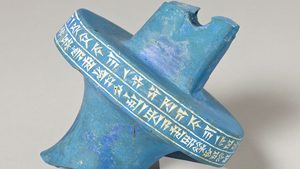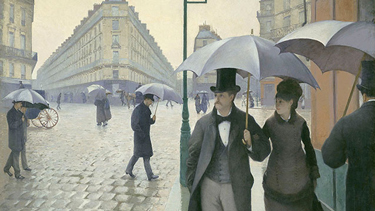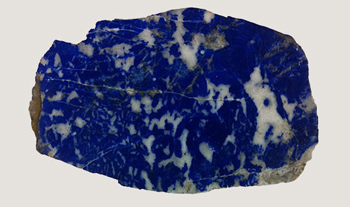Who Knew There Was So Much Blue?
Scientist studies blue’s invention and reinvention throughout history
Fifteen years ago, Northwestern University scientist Marc Walton was turned on to blue when two basic facts struck him: blue was the first man-made pigment, and the word “blue” didn’t come into existence until many years later. Intrigued, Walton set out to learn more about this “most human color.” (And, yes, blue is his favorite color.)
An expert on the history of blue, Walton is a senior scientist at the Northwestern University-Art Institute of Chicago Center for Scientific Studies in the Arts (NU-ACCESS). The center is a national model of interdisciplinary scientific research in the arts and was established in 2012 with support from the Andrew W. Mellon Foundation.
“Blue pigments can’t be readily extracted from the natural environment, so artisans across the millennia have had to use their innovative abilities to manufacture synthetic blue pigments,” said Walton, who studies the ancient world using the physical sciences, including why a magical centuries-old blue pigment recipe works.
Last weekend, as part of the Chicago Humanities Festival, he took a curious crowd at the Art Institute on a journey of blue discovery with his sold-out talk “Sacre Bleu.”
Blue’s story begins with lapis lazuli, a semiprecious stone of intense blue color, found in a remote area of Afghanistan. Very expensive and difficult to get, lapis lazuli has been prized since the beginning of recorded history, Walton said. Starting with the rise of civilization around 4500 B.C. and continuing to this day, people have found creative ways to produce blue for artistic expression.

Walton recently spoke to Megan Fellman, science and engineering editor in University Relations, about the color blue, his blue-related research and NU-ACCESS’ collaboration with the Solomon R. Guggenheim Museum.
MF: How does NU-ACCESS relate to your “Sacre Bleu” talk?
MW: One type of project the center does is technical art history, which allows us to understand how a work of art came together. There is an entire historic lineage associated with materials usage, and that’s really what this blue talk is all about -- what raw materials were used, how and why they were used, and how did artisans and artists come up with innovative ways of creating this color to express themselves and the world around them.
MF: Why blue?
MW: I think the story of blue is intertwined with the story of man’s ability to innovate and create. Though it appears to be the most abundant color in our natural world, we can’t readily dig it out of the ground. This forces us to be creative if we are to recreate the color, and that’s what makes it special.
In Anish Kapoor’s popular sculpture “Cloud Gate” (aka, “The Bean”) in Chicago’s Millennium Park, he captures the color blue by reflecting it back to us, from the sky. That’s one approach. But how did this color, so rare in the physical world, end up in countless works of art, from King Tut’s burial mask to Pablo Picasso’s painting “The Old Guitarist”?
My real interest began when I was a graduate student. I was studying Roman development of lead-glazed ceramics, while one of my colleagues was working on a pigment called Egyptian blue. From his work and my subsequent research, I learned two basic facts about the color blue that I have continued to explore ever since. The first is that blue was the first man-made pigment -- the first pigment ever engineered. And the second is that the word for blue didn’t come into existence until after this material was made by man.
Starting with the rise of civilization to present day, I am tracing how there have been different solutions for producing this omnipresent color throughout history. The natural blue we see in abundance in our sky and water is a physical phenomenon having to do with light scattering instead of it being a tangible color we can wrap our hands around. So I’ve been trying to understand how early man harnessed his environment to artificially produce this color that forms a vital part of our material culture today.
MF: What was the first tangible blue?
MW: The first blue material used by man is a mined one, a semiprecious stone called lapis lazuli. It is a really intense blue color and only came from one specific place on Earth -- the northeastern corner of Afghanistan, a very remote area. It was exploited from the beginnings of civilization around 5000 to 4000 B.C. until the present day. The fact that this single source of lapis has been used for such an extended period is one of the success stories of human history. But the key here is that lapis lazuli is a rare commodity -- difficult to mine and transport (especially in antiquity), so it’s expensive.
MF: Such a vivid blue must have really stood out from the earth colors in use long ago, the oranges, yellows, reds and whites.
MW: Blue was highly desirable but given its rarity, different solutions were needed to produce the prized color. These solutions include the birth of glass. The earliest glasses were designed to mimic semiprecious stones and were used to decorate coffins, for jewelry and as eye inlays in sculpture. All these were synthetic versions of lapis lazuli.
Blue is the first and most dominant synthetic pigment of the ancient world. And it is entirely a human invention, which is why I agree with the singer Regina Spektor when she calls blue “the most human color.”
As soon as you start to synthesize something it becomes part of the economy. The know-how spreads and you can trace trade patterns using chemical analysis of materials and artworks.

MW: Egyptian blue. It is related to glass and inspired by lapis lazuli, the true blue. It was even called that. The first glasses were glazed materials to which artisans added colorants. They pushed the chemistry and engineering of these materials to produce something that was a synthetic equivalent of lapis lazuli with its deep blue color.
Egyptian blue is the first blue pigment to be used extensively. Ancient Egyptians painted their walls with it, they painted the ceilings of their tombs to mimic the night sky -- this was almost the common man’s blue. And it was used for an extended period of time -- from the late Bronze Age (approximately 1300 B.C.) all the way through the Roman period (5th century A.D.).
But then the Romans move away from using blue as a primary color in their painting. The technology of how to make Egyptian blue dies out in the Dark Ages.
MF: What happens next?
MW: Around the 6th century A.D., all of a sudden we start to see the first sustained use of lapis lazuli as a pigment. Artisans begin crushing up this rock, which was not previously used as a pigment, into a powder to produce Buddhist wall paintings in the caves of Bamiyan, Afghanistan, not far from the original source of lapis.
It then takes about 300 years for that technology to travel 4,000 miles and reach the Mediterranean Sea and beyond. The technology is picked up in Venice around the 10th century A.D., and the pigment is called ultramarine, which literally means “over the seas.”
To make ultramarine, Venetians crushed the lapis lazuli stone, which is a mixture of blues, whites and even some yellow, and used a complex separation process to extract the blue coloring.
This processing was labor intensive, which meant that ultramarine was expensive. This could explain why it remained the primary pigment during the Renaissance for depicting such holy icons as the Virgin Mary and her robe.
Naturally, artisans were interested in finding cheaper alternatives for making the color blue. At first they started using azurite, a cheaper alternative of ultramarine blue, as an underlayer to extend the effect of the more expensive top layer. After that, cobalt blue colorants, Prussian blue -- used by such artists as Canaletto, Van Gogh and Picasso during his Blue Period -- and modern synthetic pigments were produced. Today, a plethora of organic and inorganic compounds can be used to make blue -- the color’s production has skyrocketed in the last 100 years.

MW: There is tantalizing evidence for the earliest Egyptian blue material (called a frit) dating back to Dynasty Zero, or 3100 B.C. We don’t see the word for blue appearing in the literature for another several hundred years. This is really intriguing -- the idea of developing a material without a designation -- and it opens up the question of how material discovery relates to linguistic development.
MF: How does your NU-ACCESS research fit with blue?
MW: We are currently investigating the process I mentioned earlier, where artisans during the Renaissance reinvented the 6th-century process of creating the pigment ultramarine from lapis lazuli by removing all the constituents except the mineral lazurite. To date, nobody has been able to explain this process from a scientific perspective.
The recipe for manufacturing ultramarine using the Venetian method was recorded in the 15th century A.D. by an Italian workman named Cennino Cennini in “The Craftman’s Handbook.” A lye solution was used to extract the blue-colored mineral lazurite from a waxy resin ball in which all the unwanted minerals remained. We’ve recreated this technique at NU-ACCESS, and it works beautifully, but we now want to understand why it works from a chemical perspective.
MF: I understand that one of NU-ACCESS’ first two collaborations with outside institutions includes a blue work. What is it?
MW: We are analyzing “Tp 2” a painting by László Moholy-Nagy, from the Solomon R. Guggenheim Museum in New York. It is a great example of synthetic ultramarine in modern art. While the artist knew his artwork was blue, he may not have been aware that the colorant was ultramarine as we have discovered from our analysis. This material had found its way into all manner of industrial products by this time (1930).
At NU-ACCESS, we are interested in determining who had access to various technologies at different time periods and how they innovated to achieve alternatives or improve on existing processes. We can then use this knowledge for devising conservation treatments, for determining the provenance of objects and sometimes for authentication. But it ultimately comes back to this idea of how do people innovate and evolve, which has been a lifelong interest of mine.
Today we are surrounded by technological innovations, and yet we continue to seek out the latest, greatest technology to make things better, faster, cheaper. This same impulse is evident throughout antiquity even if the timescale of change and innovation was much longer then. But it’s the same process -- ancient innovators inspired by the natural but rare source of blue (lapis lazuli) were driven by the desire to develop practical solutions to a once impractical process of creating a synthetic blue (glass). By tracing such processes in antiquity, we hope to gain a better understanding of technical innovation in our contemporary world.